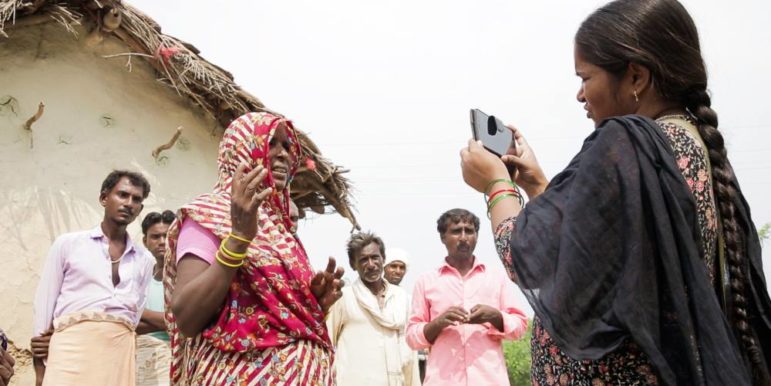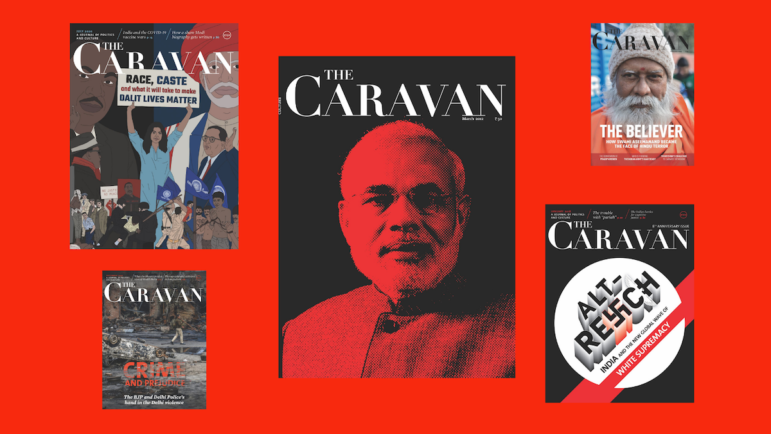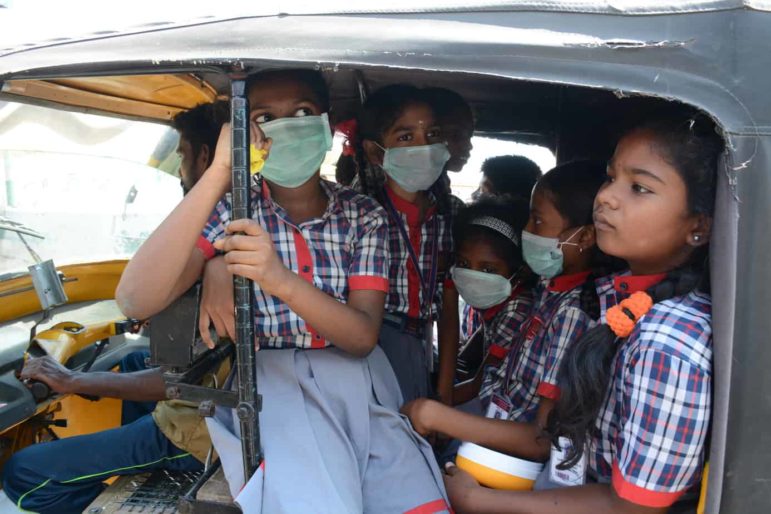

গল্পের সন্ধানে: খবর লহরিয়ার প্রতিবেদক মীরা দেবী একটি স্টোরি রেকর্ড করছেন। ছবি: ব্ল্যাক টিকিট পিকচার্স
How a Rural Women’s Paper Became a Muckraking Phenomenon in India
Read this article in
In the 1990s, a group of rural women set out to provide an antidote to illiteracy and injustice in Madhya Pradesh, the heart of rural India. Their goal was to empower other rural women in small, neglected towns and villages where illiteracy was high and problems associated with an uninformed public were thriving.
It was a risk. But it worked.
What started as a four-page experiment to inform women who were learning to read and write eventually became a newspaper that exposes everything from the malfunctions of local government to the mistreatment of women.
Their newspaper, Khabar Lahariya, has soared to national attention in the past 18 months as it gained recognition for its insights into the kind of news often ignored by India’s press. It now collaborates with mainstream, progressive and popular outlets in India, reaching a much wider audience than ever before.
Shining a Light on Rural Politics
Back in the 1990s, what happened in rural Madhya Pradesh, stayed in Madhya Pradesh.
Politicians would lie, cheat and manipulate the rural population with no accountability. Women were mistreated as a custom both within homes and in the community. Corruption was heavily institutionalized by the elected administration. And all of this was particularly bad in marginalized communities like the Dalits (the lowest rank of India’s caste system, formerly known as “untouchables”).
The lack of press coverage or any form of documentation meant these events continued largely unchallenged, allowing corruption to prevail as rural residents suffered.
Then, in 2002, a group of rural women began publishing a newspaper in Chhatarpur District, one of the poorest and least developed areas of Madhya Pradesh. They hired and trained female reporters from the local communities who eventually came to staff the game-changing publication now known as Khabar Lahariya, which translates to “A Wave of News.”
“This was a first-of-its-kind of a project developed by women from the rural areas of India,” says Disha Mullick, one of the founding members.
Empowering Women Despite Threats
Khabar Lahariya often publishes stories from villages so small they are hard to spot on a map. The newspaper now boasts a team of 25, including 15 reporters in seven locations across Uttar Pradesh, with 10 others on the production and distribution desk in Delhi.
Women’s empowerment remains at the publication’s core. “Our reporters are all women from rural and Dalit families who have been brought up in the same villages and towns they report on,” says editorial manager Pooja Pande.
Khabar Lahariya is shaking a deeply entrenched system of neglect in this part of India. They conduct investigations that reveal the failures of the state administration, calling out powerful figures and questioning violence against women and castes such as Dalit.
Their stories have exposed institutions, arousing both dismay and appreciation among local politicians.
Some reporters have received threats that they will be “silenced” or meet physical harm from local political figures — mostly, Mullick says, from “officers at the lower levels of administration.”
“Last year we did a lot of reporting on the tuberculosis epidemic that was being misrepresented by the Banda district administration, and the chief medical officer of Banda sent notices to us for misreporting,” she says.
The current district magistrate, the highest official at the district level, “thinks [they] are too negative and too critical,” according to Mullick. “He runs many important and influential WhatsApp groups, which he keeps removing and blocking us from.”
Recognition Brings Audience Growth
Challenging the powerful is at the heart of good journalism. And readers are recognizing the work that Khabar Lahariya — now a multi-platform media outlet working in print, online and video — is doing.
“We know that on YouTube, our content is on the lists of suggested videos for viewers in our regions, numbers that are growing everyday,” says Mullick. “Everyone reads it!”
In 2017, they hit a mark of one million monthly pageviews on their website. Before going online, their readership was in the thousands.
What these tenacious women did with a simple idea is impressive: they made rural journalism a movement in India. Over the years, Khabar Lahariya’s journalism has spread from smaller towns of India to nationally acclaimed, mainstream platforms.
They are becoming a voice for justice, both for women and for the rural communities across India.
This post first appeared on the Splice Newsroom site and is reproduced here with permission.
 Kiran Nazish is an independent journalist covering South Asia and the Middle East. She has written for the Los Angeles Times, Washington Post and Al-Jazeera. Nazish is also the co-founder of the Coalition for Women in Journalism.
Kiran Nazish is an independent journalist covering South Asia and the Middle East. She has written for the Los Angeles Times, Washington Post and Al-Jazeera. Nazish is also the co-founder of the Coalition for Women in Journalism.









